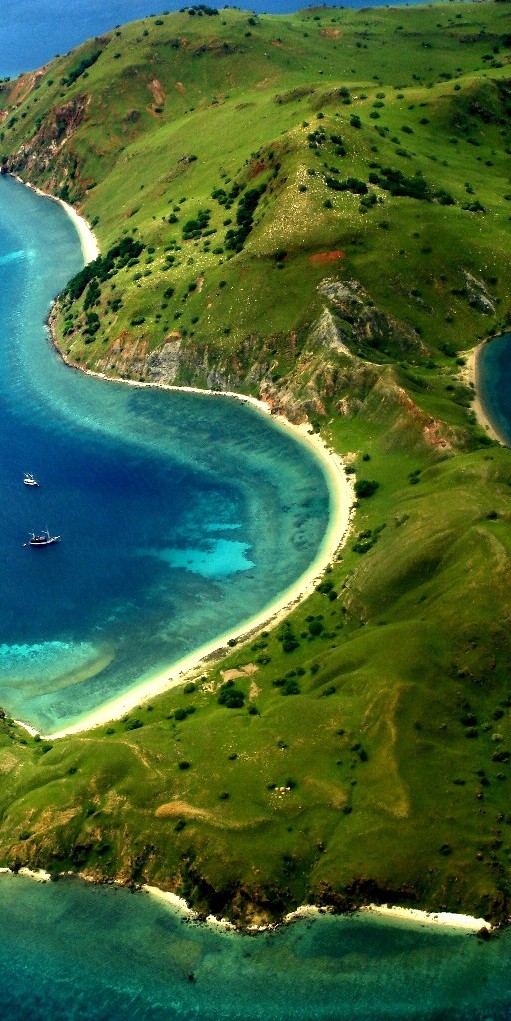 The golden sky glimmers in the east, as the day dawns upon the stunning sphere of Raja Ampat. And it happened to be the dawn of an unforgettable adventure… an encounter with orcas at this heart of the world-renowned global coral triangle...
The golden sky glimmers in the east, as the day dawns upon the stunning sphere of Raja Ampat. And it happened to be the dawn of an unforgettable adventure… an encounter with orcas at this heart of the world-renowned global coral triangle...At first light, the monitoring team of The Nature Conservancy (TNC) was fully occupied with the various activities of checking and preparing the monitoring and diving gear, fueling the speedboat, checking engines, reviewing logistics and provisions, and checking navigation and communications equipment. On this day, the team is to carry out ecological monitoring routines on reef health and fish spawning aggregation sites around Misool, in the southern part of the Raja Ampat archipelago.
Within the hour everything was set, and Andreas Muljadi, leader of the monitoring team, passed the order to the speedboat captain to depart from Sorong harbor. The speedboat, named Fayam - "eagle ray" in the local Matbat language, cruised out to sea at a gradual speed, bringing the team to the area which is widely considered as the archipelago's 'Marine Mecca'.
The sky had turned to clear blue as the team reached the Dampier Strait, which is between the islands of Batanta and Waigeo. It was just eight o'clock. Several small islands started to come into view with their soft white sands and vivid, breathtaking coral surroundings. Andreas sat at the bow of Fayam, taking in all the joy of seafaring, while the other team members sat at the back of the vessel.
Suddenly Andreas saw a spout of seawater in the air in the distance... "Whale!" Andreas cried. The team members tried to figure out the whale's position. The captain slowly steered Fayam toward what seemed to be a pod of whales. As they approached, the engines were taken out of gear and silenced. Six whales came into view, swimming and playing in water.
Two whales curiously approached Fayam's starboard as the boat drifted to a stop while the other whales flapped their flukes in the water and jumped and spun their bodies. The two that approached Fayam were more inquisitive and seemed to observe the speedboat that carried the monitoring team. They swam and dove under the boat and emerged the other side.
The team was thrilled and very happy because this whale species that have come so close to them at this moment were orcas (Orcinus orca) - killer whales. These toothed whales are known to inhabit colder seas, grow up to over 7 meters long, have tall dorsal fins, and feed mainly on fish and squid. This species is uncommon in Indonesian waters. Orcas have a unique black and white color combination, making it very easy to recognize them - a sighting that caught us by surprise.
We didn't want to lose this incredible moment. Andreas grabbed his camera and took a number of photos. The other team members watched on uttering constant remarks about their physical appearance and behavior. They also made sure of recording the coordinates with Global Positioning System.
Raja Ampat's local community has frequently seen orcas around Kofiau-Boo Island. On several occasions they discovered orcas swimming off the beach at the front of their village. The locals call these visiting cetaceans rowetroyer and hold this intelligent sea mammal in high regard. If they come across an orca during fishing, they will head back to shore as a sign of respect for the orcas; they don't want to spoil the creatures' activities.
Time passed fast. For over an hour that the team observed the pod. It was then nine o'clock and the team continued on their trip to Misool.
Upon arrival, they went to Haitlat Island which was the first site for monitoring reef health and fish populations. The team prepared their diving and monitoring gear and go ready. Monitoring is conducted at three depth levels; 4, 8 and 12 meters and is repeated five times at each level.
After three days of monitoring, the team finished data collection around the seas of Haitlat, Laitat, Masawan, Konawat, Senyu Besar, and Senyu Kecil Island and the coastal area of north and southeast Misool. On the fourth day, the team headed back to Sorong.
Tired from a long sea journey, the team members were back with big smiles on their faces, a sigh of relief from completing a successful mission, as well as the unforgettable experience of spending half of the journey with these incredible sea mammals. From the bottom of their hearts, they prayed for the protection of Raja Ampat's marine richness in which orcas find comfort during their seasonal ocean passing, and perhaps making its waters their 'home'.
fotografer : Adityo/TNC
source : http://www.baliandbeyond.co.id/archieves/archieve-frameset.htm



 Kepulauan Wakatobi terletak di Sulawesi Tenggara. Kata Wakatobi sendiri berasal dari dari 4 pulau utama yaitu Wanci, Kaledupa, Tomia dan Binongko. Terdapat puluhan pulau-pulau kecil lainnya disekitarnya. Mayoritas penduduk yang tinggal di kepulauan ini adalah suku Bajo dan Liya. Untuk berkunjung ke Wakatobi, diperlukan perjalanan kurang lebih 10 jam dengan menggunakan kapal penumpang dari Kendari menuju Wanci (ibukota Kabupaten Wakatobi). Alternatif lain adalah menggunakan kapal cepat kurang lebih 4 jam dari Kendari menuju Bau-Bau di pulau Buton dan dilanjutkan dengan kapal penumpang regular selama 6-8 jam menuju Wanci.
Kepulauan Wakatobi terletak di Sulawesi Tenggara. Kata Wakatobi sendiri berasal dari dari 4 pulau utama yaitu Wanci, Kaledupa, Tomia dan Binongko. Terdapat puluhan pulau-pulau kecil lainnya disekitarnya. Mayoritas penduduk yang tinggal di kepulauan ini adalah suku Bajo dan Liya. Untuk berkunjung ke Wakatobi, diperlukan perjalanan kurang lebih 10 jam dengan menggunakan kapal penumpang dari Kendari menuju Wanci (ibukota Kabupaten Wakatobi). Alternatif lain adalah menggunakan kapal cepat kurang lebih 4 jam dari Kendari menuju Bau-Bau di pulau Buton dan dilanjutkan dengan kapal penumpang regular selama 6-8 jam menuju Wanci.


